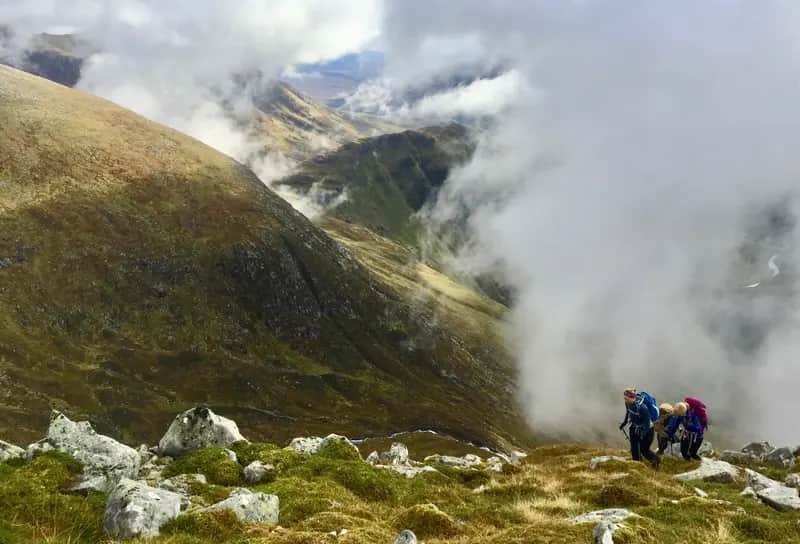DAY OF TOIL IN DEEP, SOFT SNOW ON THE ATHOLL HILLS

A FEW STEPS TOO FAR: Looking back to the Beinn a' Ghlo hills on a perfect day of blue and white from Beinn Mheadhonach

DISTANT TARGET: Beinn Mheadhonach
JUST one of those days, a stunning interval of calm between storm systems, a blanket of white on the hills protected by an endless awning of blue.
We had travelled north with a generous helping of tequila sunrise spilling across the horizon, the pink, yellow, orange, gently encroaching as the waning Snow Moon retreated.
Despite this settled structure, we decided against carrying on too far up the A9, sacrificing the planned Drumochter walks to focus on routes running north from Blair Atholl.
There was a bite in the air as we set off in the newborn light beside the whispering waters of the Tilt, one party heading for the Munro Carn a' Chlamain, another for the Corbett Beinn Mheadhonach and a third exploring the wide open spaces of Glen Banvie. These are long approaches to distant hills, feeling even longer in deep, soft snow, and although the turnaround time appeared generous, we expected a hard day's walking.
The course was split between light and shade; golden tips on parts of the treeline, glistening frozen water beads hanging like teardrops from bare branches, black skeletal fingers reaching up as though trying to touch the brightness which always appeared to be just out of reach. The waters either sparkled or glowered depending on where you stood as they swept over and around rocks wearing white top hats, changing personality after passing under the series of old stone bridges along the way.
Just one of those days when there was a fresh delight round every corner, when every step onward promised something better, a continuous crop of carrots to lure you on.
The crossing of the little bridge over the Allt Mhairc marked another significant change, as the trees disappeared, the snow reached serious depths and the challenge ahead became magnified. The unblemished bulk of Beinn Mheadhonach stretched ahead into the blue, its pure-white slope giving a false perspective of the distance and height still to be travelled.
The trail-breaking was tough on the next leg above the twisting gorge, the building heat also beginning to take a toll. One more bridge and the real climbing began, every step a plunge up to the knee, every effort to gain traction a challenge.
The group was becoming strung out. It didn't need a mathematician to work out that our time/distance formula was about to disengage. Mine, in particular, was unravelling fast. Suddenly, I was falling further behind the leaders, struggling to put another foot forward. My neck and shoulders were aching, I felt as though I couldn't lift my head. A wave of exhaustion washed over me.
We still had an hour and a quarter to reach the summit and it didn't look too far away but I knew I would never make it in that time. I had come to a standstill. There was no point in struggling on, better to let those who could crack on go for it. I signalled I was turning back.
It could have been lack of sleep, or the too-heavy pack. It could have been that I was overdressed – the forecast was for minus four with a windchill taking it to minus 13: the reality was that the lack of wind and strong sun shot those figures clean out of the pure blue sky. Or it could have simply been that it was too many steps too soon just three weeks after having Covid. Most likely, it was a combination of all of the above.
It was similar to an experience I had three years ago on the Corryhully Horseshoe. I had started at first light (no sleep) with full winter kit, a mammoth pack and heavy camera gear. Two hours later, I couldn't put one foot in front of the other. My neck and shoulders ached and I couldn't lift my head. I sat down then fell asleep. After a five-minute snooze, I realised I wouldn't be going any further.
Knowing when to turn back on the hill is a valuable trait. There's no point in pushing on when you know things are not right.
The experience of those who kept going confirmed that my decision had been the correct one. Only four out of a party of 12 made it to the top. That short push to the summit from where I left them took much longer than anticipated: they needed every minute of the allotted time.
On such a beautiful day, the long, winding route back down the glen was no hardship, although there were times I wished I could lie down for a short nap.
I had made the right choice but that didn't prevent the internal post mortem taking place. The findings? Just one of those days.

